Our quest for summer pours brought us to Molon Lave. We first visited the winery when it first opened about two years ago, so we knew that we were due for a re-visit. Since that time, the tasting menu has expanded to include kosher wines!
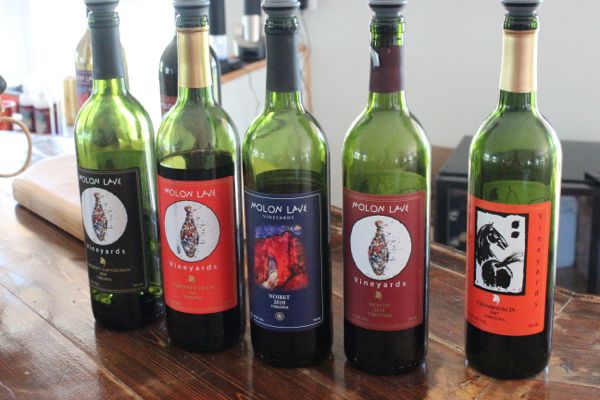
Molon Lave is Greek and roughly translate to, “Come and Get Them”, and that is what we planned to do—get the wines that is. Katherine, daughter of owner Louizos Papadopoulos, warmly greeted us and recalled our first visit to Molon Lave. She updated us on the developments at Molon Lave that include an expansion of the wine menu to include ten wines. Riesling, Vidal Blanc, Chambourcin, Merlot, Noiret, Cabernet Franc, and Cabernet Sauvignon are some of the estate-grown varieties that are now for sale at the winery. Our goal was to identify wines appropriate for the hot and humid days of Virginia summertime, and Paul’s favored the fruity 2010 Vidal Blanc with its peachy flavors. Aged in stainless steel, it should be enjoyed on its own or with a light picnic lunch, fresh fruit, and light cheeses. Katie’s Charm should delight rose lovers who appreciate the Chambourcin grape. Bright strawberry notes and a characteristic tart finish make for the perfect wine to bring to a Wolftrap concert. Outdoor grilling might call for a red wine, and the 2010 Cabernet Franc was my own personal favorite. This spicy red wine was aged for 12 months in American oak barrels and presented flavors of blackberry and raspberry. Sweet wine lovers might enjoy the Autumn Nectar, a blend of late harvest Rielsing, Pinot Gris and Viognier. At 2.5 residual sugar, it should be fine with dessert; however, our friend Michael Tyler would probably sip this one on its own.
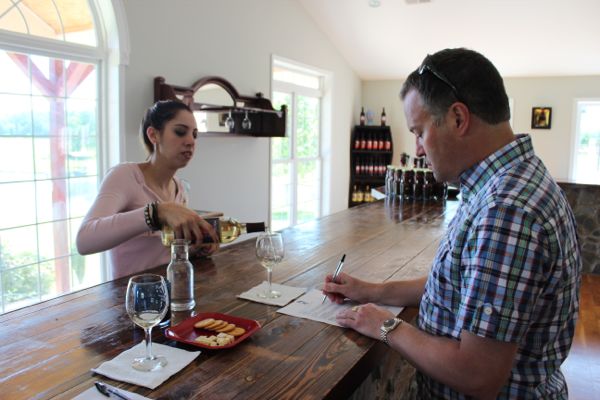
We were very intrigued with the kosher wines, and winemaker and owner Louizos Papdopoulos was on hand to answer our questions about this process. Louizos became interested in producing kosher wines due to his business dealings both here and in New York City; he discovered that Jewish communities were interested in local wines, but they had no local options for kosher wines. Louizos decided to fill this void and pursued the process of making kosher wines. Kosher wines are made according to strict Jewish dietary laws, and only a rabbi can make the wines. These laws and practices go back to ancient bibilical times. At Molon Lave, a rabbi now makes three kosher wines, and these include the 2010 Riesling, the upcoming 2010 Chardonnay, and the smoky 2010 Noiret, a hybrid red grape. The wines have become popular sellers, and Molon Lave was the first Virginia winery and among very few east coast wineries to produce kosher wines.
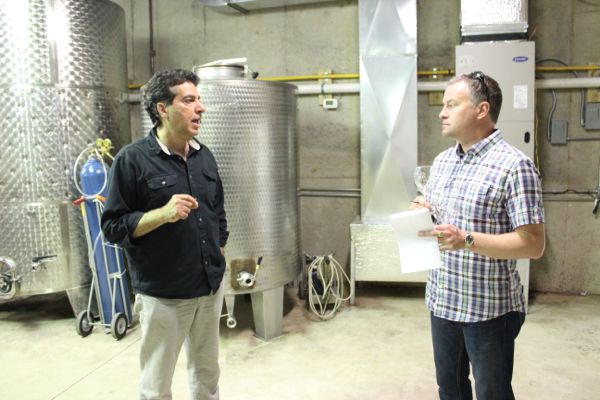
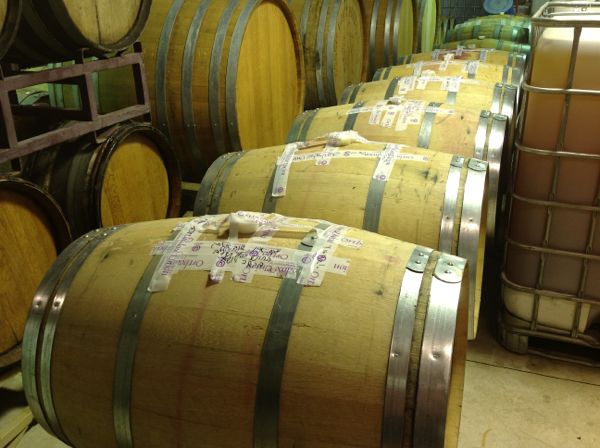
Louizos filled us in on future goals for Molon Lave, and these include a continuation of the kosher wines. He also intends to plant an additional 20 acres of vines to include more of the varietals now grown on the estate with Traminette being added to the mix. The overall winemaking philosophy will remain the same, though, and that is to produce fruit-forward, drinkable wines.
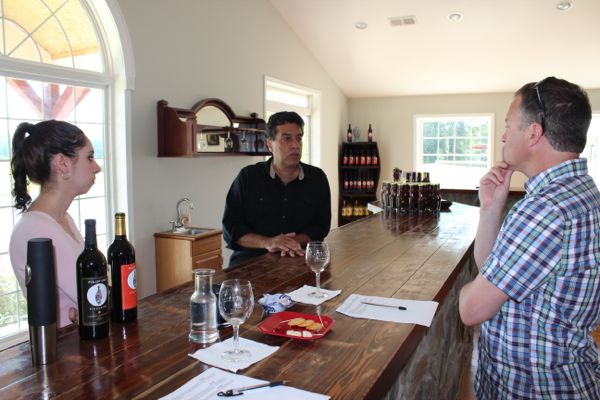
With our tasting done, we decided to enjoy a glass of Katie’s Charm with a plate of salami, cheeses, and Greek olives. We walked up to the pavilion and enjoyed a panoramic view of the lovely grounds at Molon Lave. We made certain to leave with bottles of summer favorites, and we plan to visit sooner to keep abreast of developments at Molon Lave. Be sure to visit Molon Lave for a tasting, but be sure to mention that Virginia Wine Time sent you.
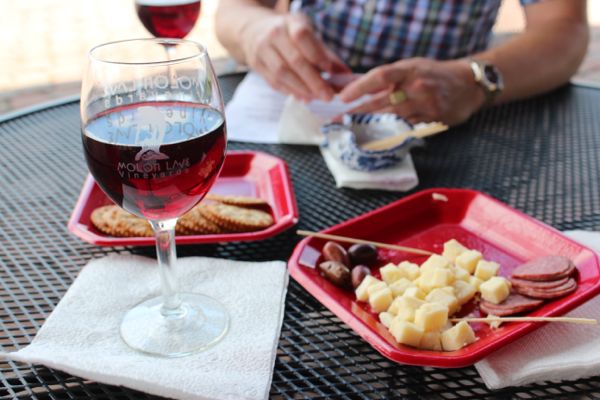
Author: Warren
Time For Summer Sippers
Yes, it’s that time of the year to put away the bolder wines until the fall and to crack open the crisper, lighter-bodied white wines and fruitier red wines. Our mission to stock up on warm-weather wines brought us to Naked Mountain Winery.
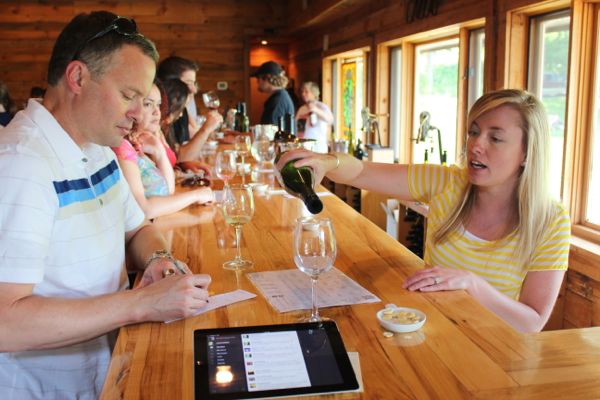
The 2011 offerings at Naked Mountain seemed to meet our expectations for white wines from the 2011 vintage—fruity and refreshingly acidic. The 2011 Viognier presented one such example. Nice melon citrus aromas were matched with flavors of pear and melon. A higher acidity level led to a crisp finish. Perfect on its own or serve well chilled with light cheeses or shellfish. For sweeter wine lovers, the 2011 Chardonnay Riesling should fit the bill. A residual sugar level of 2.5% made for a fruity wine with peach and apple flavors. Our friend and guest blogger Michael Tyler, a fan of fruity white wines, would really love this one while grilling on the deck on a hot afternoon! He might even save a glass for me!
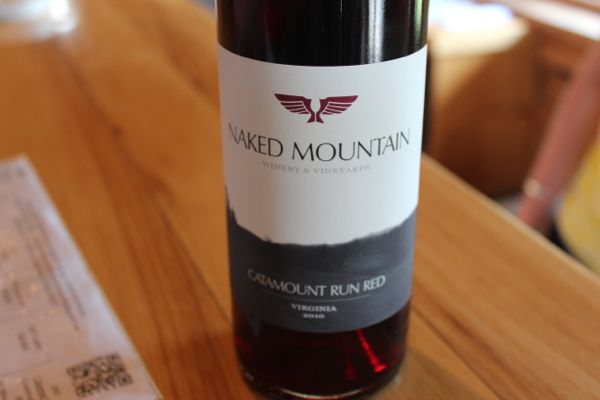
White wine lovers who find themselves in a dither at barbeques might appreciate the 2010 Catamount Run Red. Spicy barbeque sauces and char-grilled fare that once mooed may not seem like a match with sweet white wines; however, this fruity red wine should woo white wine drinkers. Slightly sweet with a bright, fruit forward presence should partner quite nicely with burgers, ribs, and sausages. If heavier meats are on the grill, Paul’s favorite, the Raptor Red, might be a better match. This non-vintage pour is a blend of wines from the 2007 and 2008 vintages. Its smoky nose gave way to aromas of dark seed berries and tobacco.
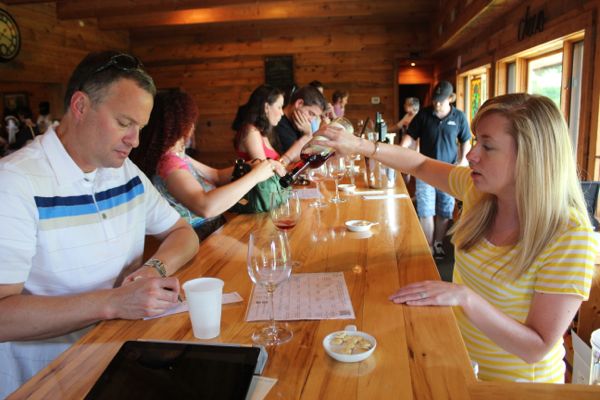
If a cheese course or cheesecake is on the dessert menu, opt for the 2011 Old Vine Riesling. At 6% residual sugar, it is certainly a dessert wine and presented floral aromas with apricot notes and hints of green apple.
It was indeed a hot day, and we refreshed ourselves with a glass of the 2011 Viognier. It proved to be the perfect pour to complement a warm, muggy afternoon. Be sure to consider Naked Mountain Winery when shopping for your own summer sippers, and please mention that Virginia Wine Time sent you.
Celebrating 250 Years!
Philip Carter Winery celebrated the 250th anniversary of winemaking in Virginia. A black tie event kicked off the celebration on Friday, May 25 and then continued into Saturday with more casual events that included carriage rides, barbeque, fencing, and live music.
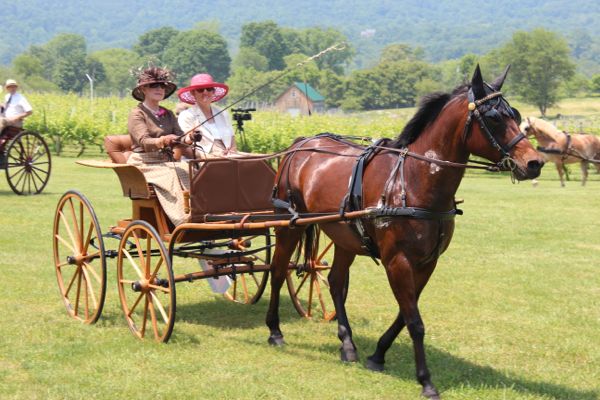
The black tie event featured a “history through tasting” that showcased wines from some of the state’s oldest wineries. These included Barboursville Vineyards, Horton Vineyards, Jefferon Vineyards, Philip Carter Winery, and Williamsburg Winery. However, we attended the Saturday event, and while Paul was anxious to wear his period clothing (powdered wig included), we enjoyed a very warm afternoon in our summer attire. In addition to celebrating an important milestone, we also took advantage of an opportunity to sample the latest releases from Philip Carter Winery.
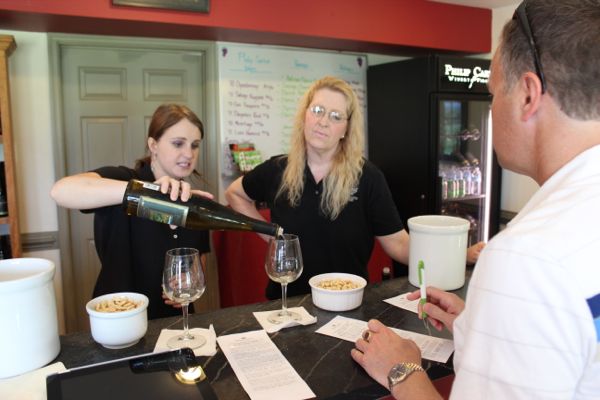
I’ll get into the wines first. I’ve always been a fan of Philip Carter’s Chardonnay, and I really enjoyed the 2011 Chardonnay that was released on the anniversary weekend. Like its 2010 sibling, the 2011 vintage exhibited a creamy texture on the mid-palate due to malo-lactic fermentation; however, a partial blending with Chardonnay from stainless steel tanks also provided a degree of crispness. It presented ripe pear and citrus characteristics with a nice acidity that we increasingly associate with the more positive elements of the 2011 vintage. Just in time for summer, the 2011 Governor Fauquier is a blend of Vidal Blanc and Chardonnay; done in stainless steel, it is full of bright apple flavors.
Of the red wines, I enjoyed the 2011 Cabernet Franc. This is the first bottled red wine that I’ve experienced, and it met my expectations for the 2011 reds. Fruity and lighter bodied, this Cabernet Franc is blended with Petit Verdot (10%) and Tannat (9%) and then aged for nine months in both French and American oak barrels. I noted lots of cherry aromas and flavors with a peppery finish. The smoky 2010 Meritage, though, presented a more complex pour. This blend of Cabernet Franc (42%), Petit Verdot (32%), Cabernet Sauvignon (21%) and Merlot (5%) exhibited elements of dark fruit, sweet tobacco, and black pepper with a notable tannic presence to suggest that an age-worthy wine. Serve now but decant; better yet, buy now and wait to enjoy at its peak.
Other new releases included the full-bodied 2011 Sabine Viognier, a first-ever release of a Viognier from Philip Carter Winery and the fruity 2011 Late Harvest made from Vidal Blanc. The 2011 Rose was also poured, and we’ve written about it in an earlier post; I do think it is a very good Rose and made sure to purchase a bottle for the summer.
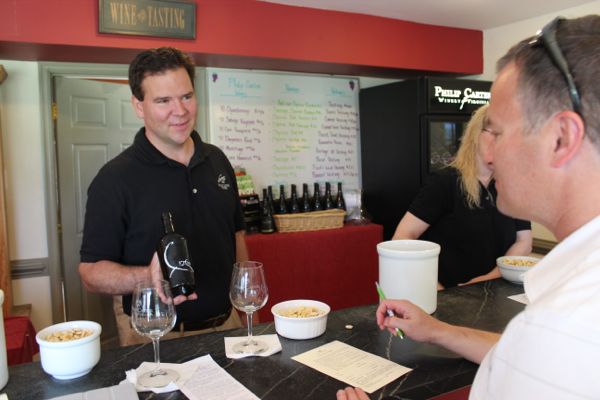
In the midst of our tasting, we met up with Philip Carter Strother, owner of the winery. It was certainly a proud day for Philip Strother, whose ancestor, Philip Carter, acquired the original deed to the property on which the first vineyards in Virginia were planted. In fact, Strother can now exhibit both the originial charter and a recent legislative proclamation that recognizes the Carter wine legacy. Strother also shared with us the bottle for the soon to be released port called 1762. Wine expert Richard Leahy was also on hand to help with the celebration, and Richard was available to chat about Virginia wine and to sign copies of his newly released book, Beyond Jefferson’s Vines.
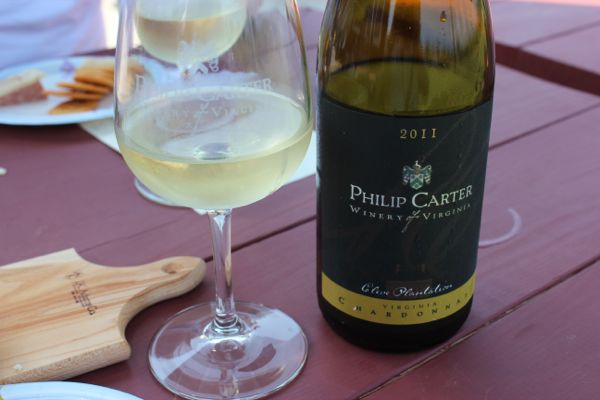
We completed the anniversary celebration with a glass of the 2011 Chardonnay, and an outdoor seat beneath a shady umbrella allowed us to watch antique-style carriages drawn by horses and ponies taxi riders about the vineyards. Fencers in full attire made lunges toward each other, and Paul bemoaned a missed opportunity to wear his velvet knee-britches, buckled shoes, and powdered wig. I assured him that there is always Halloween! We made certain to purchase our favorite Philip Carter wines. Be certain to celebrate the 250th anniversary of wine making in Virginia with a visit to Philip Carter Winery, but be sure to mention that Virginia Wine Time sent you.
TasteCamp Day Three
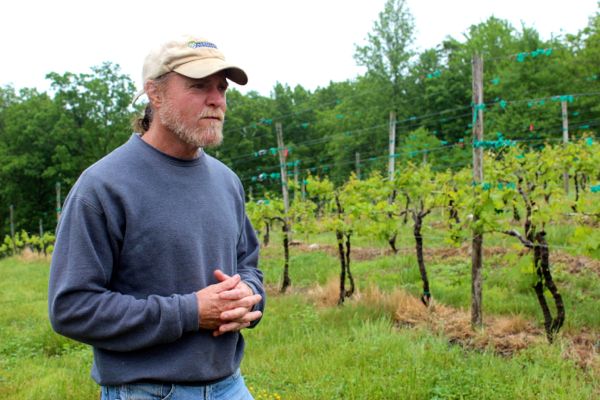 Jim Law of Linden headlined the TasteCamp finale, and he conducted a personal tour of his Hardscrabble site for campers. Jim is something of a god here in Virginia, so this opportunity for campers to meet the man who inspired the sea change in Virginia’s winemaking was truly an incredible experience. Jim’s tour ended with a tasting of his wines, and taste camp ended on the highest note possible.
Jim Law of Linden headlined the TasteCamp finale, and he conducted a personal tour of his Hardscrabble site for campers. Jim is something of a god here in Virginia, so this opportunity for campers to meet the man who inspired the sea change in Virginia’s winemaking was truly an incredible experience. Jim’s tour ended with a tasting of his wines, and taste camp ended on the highest note possible.
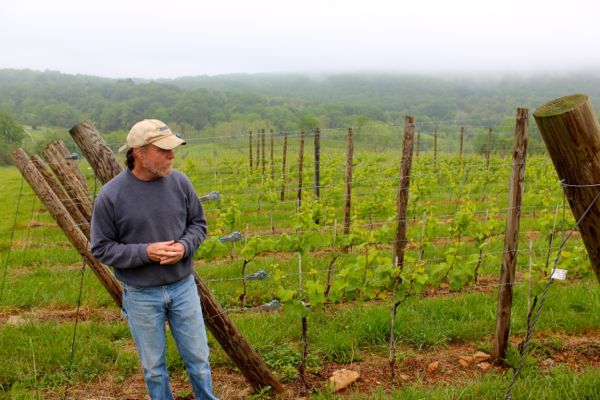 Taste campers met Jim on a very foggy and chilly morning to tour his Hardscrabble site. Jim has been making wine at the Hardscrabble vineyard since at least 1987, and he began the tour at his block of oldest chardonnay vines; however, lest we think that Jim contently sits on his laurels and lets 25 year- old vines do their thing, campers were informed otherwise. Jim is in the process of renovating and replanting his vineyard so that particular varietals are planted in the most appropriate soils and microclimates. Blocks of merlot are being uprooted and then replanted with chardonnay. Carmenere is being grafted onto merlot to produce more merlot. Poorly performing carmenere will be phased out. New vines will be spaced closer together. Canopy management will change too. A recent trip to Bordeaux vineyards revealed to Jim that merlot grapes actually do not like plentiful sunshine, and overly ripened merlot produces jammy, uninteresting wines associated with the mediocre stuff associated with California. Therefore, Jim will make the necessary adjustments with his merlot vines. What does all of this say about Jim Law? I concluded that Jim stays at the top of his game because he always seeks to improve. Jim constantly referenced his desire to “get better” or “make better wine”; although other area winemakers often acknowledge Jim as their teacher, mentor, or hero, it was obvious to me that Jim still considers himself to be a student. Perhaps it is for this reason that his wines consistently set the bar for quality in Virginia.
Taste campers met Jim on a very foggy and chilly morning to tour his Hardscrabble site. Jim has been making wine at the Hardscrabble vineyard since at least 1987, and he began the tour at his block of oldest chardonnay vines; however, lest we think that Jim contently sits on his laurels and lets 25 year- old vines do their thing, campers were informed otherwise. Jim is in the process of renovating and replanting his vineyard so that particular varietals are planted in the most appropriate soils and microclimates. Blocks of merlot are being uprooted and then replanted with chardonnay. Carmenere is being grafted onto merlot to produce more merlot. Poorly performing carmenere will be phased out. New vines will be spaced closer together. Canopy management will change too. A recent trip to Bordeaux vineyards revealed to Jim that merlot grapes actually do not like plentiful sunshine, and overly ripened merlot produces jammy, uninteresting wines associated with the mediocre stuff associated with California. Therefore, Jim will make the necessary adjustments with his merlot vines. What does all of this say about Jim Law? I concluded that Jim stays at the top of his game because he always seeks to improve. Jim constantly referenced his desire to “get better” or “make better wine”; although other area winemakers often acknowledge Jim as their teacher, mentor, or hero, it was obvious to me that Jim still considers himself to be a student. Perhaps it is for this reason that his wines consistently set the bar for quality in Virginia.
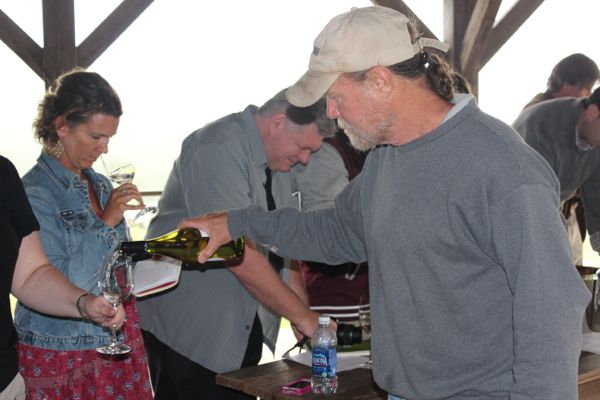 Jim then led us to the crush pad for a tasting of his wines. The fog intensified as barn swallows frantically fluttered around, and a Gothic feel permeated the atmosphere as Jim presented his wines. These included the 2011 Avenius Sauvignon Blanc, 2009 Harscrabble Chardonnay, 2008 Hardscrabble Red, and 2009 Avenius Red. As the fog encircled us, it was hard to miss Jim’s Old World style of winemaking. Elegant and focused, integrated and balanced—these wines were indeed at the top of the class. It was here that I heard the highest praises of the weekend with one New York camper commenting that Jim’s wines were “world class.”
Jim then led us to the crush pad for a tasting of his wines. The fog intensified as barn swallows frantically fluttered around, and a Gothic feel permeated the atmosphere as Jim presented his wines. These included the 2011 Avenius Sauvignon Blanc, 2009 Harscrabble Chardonnay, 2008 Hardscrabble Red, and 2009 Avenius Red. As the fog encircled us, it was hard to miss Jim’s Old World style of winemaking. Elegant and focused, integrated and balanced—these wines were indeed at the top of the class. It was here that I heard the highest praises of the weekend with one New York camper commenting that Jim’s wines were “world class.”
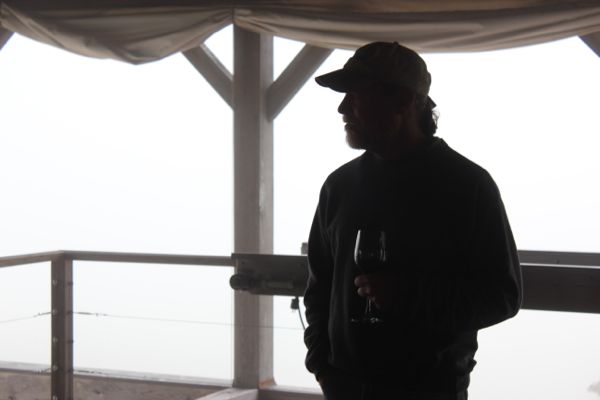 Reflections: So what did I learn from taste camp? Winemaking is a tough business, and the phrase, “winemaking starts in the vineyard”, may seem cliché, but indeed it is true. The vineyard management alone should frighten off all but the most dedicated and passionate. There are many decisions and tasks involved just with the vineyard management. Which site to select? Which varieties to plant, and then which clones? What about trellising—smart dyson to maximize production? Mow the lawn or let the weeds grow to soak up some unwanted moisture? Pick now or gamble on the weather? Needless to say, there are many more decisions to be made once grapes are harvested and then fermented and aged. Serious winemaking is not for the hobbyist, and even most seasoned veterans must be opened to changes if they wish to constantly raise the quality of their wines.
Reflections: So what did I learn from taste camp? Winemaking is a tough business, and the phrase, “winemaking starts in the vineyard”, may seem cliché, but indeed it is true. The vineyard management alone should frighten off all but the most dedicated and passionate. There are many decisions and tasks involved just with the vineyard management. Which site to select? Which varieties to plant, and then which clones? What about trellising—smart dyson to maximize production? Mow the lawn or let the weeds grow to soak up some unwanted moisture? Pick now or gamble on the weather? Needless to say, there are many more decisions to be made once grapes are harvested and then fermented and aged. Serious winemaking is not for the hobbyist, and even most seasoned veterans must be opened to changes if they wish to constantly raise the quality of their wines.
I also learned that Virginia winemakers are still sorting out what varieties work for Virginia, and this seems to be a site-by-site decision. Jordan Harris will be focusing more on Rhone varieties while Law will intensify his focus on merlot and chardonnay. Doug Fabbioli, the Bootstrapper, will continue to innovate not only with traditional viniferous grapes but also with hybrids (like chambourcin) as well as fruit wines. Ben Renshaw enjoys the challenge of vineyard management and seems to revel in working with a more diverse crop—his favored Tranquility site grows traditional grapes such as cabernet sauvignon while the Goose Creek vineyard located across the road produce German varieties such as lemberger and dornfelder. What was a common thread between all of these winemakers? The sense of passion that even the most oblivious would have noticed.
Buzz: So which wines generated the most buzz? I tried to document as many comments as possible, so it is likely that I missed a few of the hitmakers from the weekend. With that in mind, here is my list of all-stars that generated the most buzz:
2010 Ankida Ridge Pinot Noir
2011 Boxwood Rose
2007 Boxwood Red (actually a split between this and the 2007 Topiary)
2011 Blenheim Rose
2002 Breaux Reserve Merlot
2001/2005 Breaux Nebbiolo
2008 Linden Hardscrabble Red
2009 Linden Hardscrabble Chardonnay
2010 North Gate Rousanne
2011 Stinson Sauvignon Blanc
2007 Tarara Syrah
2011 Tarara Petit Manseng
2011 White Hall Viognier
2010 Zepahiah Farms Chambourcin Reserve
TasteCamp offered an opportunity for campers to learn (and taste) more about winemaking in Virginia. We thank the TasteCamp organizers for planning this event, and we encourage readers to visit Virginia wineries to sample the latest releases. Create your own buzz (uh-a list of favorite Virginia wines, course). Remember to mention to the winemakers that Virginia Wine Time sent you.